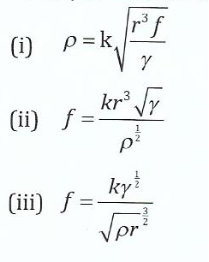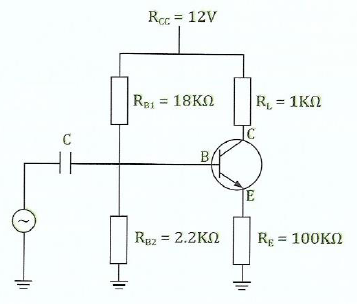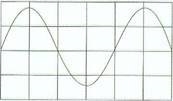THE UNITED REPUBLIC OF TANZANIA NATIONAL EXAMINATIONS COUNCIL OF TANZANIA ADVANCED CERTIFICATE OF SECONDARY EDUCATION EXAMINATIONS
131/1 PHYSICS 1
(For Both School and Private Candidates)
Time 3 Hours Year: 2013
Instructions
1. This paper consists of sections A and B with a total of ten (10) questions.
2. Answer all questions in section A and two (2) questions from section B.
3. Section A carries seventy (70) marks and Section B carries thirty (30) marks.
4. Marks for each question or part thereof are indicated.
5. Mathematical tables and non-programmable calculators may be used.
6. Cellular phones and any unauthorized materials are not allowed in the examination room.
7. Write your Examination Number on every page of your answer booklet(s).
8. The following information may be useful:
Thermal conductivity of copper = 400Wm 11<-1
Acceleration due to gravity g -10m/s2
Stefan's constant
Exponential constant e = 2.7
Electronic charge e = 1.6 x 10-19C
Temperature coefficient of resistance for nichrome = 8.0 x 10 51C1
Resistivity of nichrome at 373K = 1.08 x 10 6QM
1. (a) (i) What is the difference between degree of accuracy and precision?
(ii) In an experiment to determine Young's modulus of a wooden material the following measurements were recorded:

3
View Ans
(b) Using the method of dimensions, indicate which of the following equations are dimensionally correct and which are not, given that, f = frequency, y = surface tension, p = density, r = radius and k = dimensionless constant.

View Ans
2. (a) (i) List down two assumptions in deriving the equation of projectile motion. (ii) Why is the horizontal motion of a projectile constant?
View Ans
(b) A ball is thrown horizontally with a speed of 14.0 ms-I from a point 6.4 m above the ground. Calculate:
(i) The horizontal distance travelled in that time.
(ii) Its velocity when it reaches the ground.
View Ans
3. (a) Why is it technically advised to bank a road at corners?
View Ans
(b) A wheel rotates at a constant rate of 10 revolutions per second. Calculate the centripetal acceleration at a distance of 0.80m from the centre of the wheel.
View Ans
(c) (i) With the aid of a labelled diagram, sketch the possible orbits for a satellite launched from the earth.
(ii) From the diagram in (c) (i) above, write down an expression for the velocity of a satellite corresponding to each orbit.
View Ans
4. (a) (i) Distinguish surface tension from surface energy.
(ii) Explain the phenomenon of surface tension in terms of the molecular theory.
View Ans
(b) A clean open ended glass U-tube has vertical limbs one of which has a uniform internal diameter of 4.0 mm and the other of 20.0 mm. Mercury is poured into the tube; and observed that the height of mercury column in the two limbs is different.
(i) Explain this observation.
(ii) Calculate the difference in levels.
View Ans
5. (a) Name the temperature of a thermocouple at which the thermo,
(i) e.m.f changes its sign
(ii) electric power becomes zero.
View Ans
(b) (i) A person sitting on a bench on a calm hot summer day is aware of a cool breeze blowing from the sea. Briefly explain why there is a natural convection.
(ii) A Nichrome-constantan thermocouple gives about 70 VIV for each I O C difference in temperature between the junctions. If 100 such thermocouples are made into a thermopile, what voltage is produced when the junctions are at 20 0 C and 240 0 C?
View Ans
(c) A black body of temperature 0 is placed in a blackened enclosure maintained at a temperature of IO O C. When its temperature rises to 30 0 C the net rate of loss of energy from the body was found to be 10 watts. Find the power generated by the body at 50 0 C if the energy exchange takes place solely by the process of forced convection.
View Ans
6. (a) Compare the law governing the conduction of heat and electricity pointing out the corresponding quantities in each case.
View Ans
(b) (i) Write down three laws governing the black body radiation.
(ii) A cup of tea kept in a room with a temperature of 22 0 C cools from 66 0 C to 63 0 C in 1 minute. How long will the same cup of tea take to cool from the temperature of 43 0 C to 40 0 C under the same condition?
View Ans
(c) A lagged copper rod is uniformly heated by a passage of an electric current. Show by considering a small section dx that the temperature 0 varies with distance x along a rod in a way that, 
, where k is a thermal conductivity and H is the rate of heat generation per unit volume.
View Ans
7. (a) (i) Define the term standing wave.
(ii) State the position in a stationary wave where a man can hear a louder sound.
View Ans
(b) (i) What is meant by dispersion of waves?
(ii) Briefly explain if it is possible for dispersion to take place on a wave whose frequency lies in the audible range.
View Ans
(c) A small speaker emitting a note of frequency 250Hz is placed over the open upper end of a  vertical tube which is full of water. When the water is gradually run out of the tube the air column resonates. If the initial and final position of water surface below the top is 0.31m and 0.998m respectively, calculate the speed of sound in air and the end-correction of the tube.
vertical tube which is full of water. When the water is gradually run out of the tube the air column resonates. If the initial and final position of water surface below the top is 0.31m and 0.998m respectively, calculate the speed of sound in air and the end-correction of the tube.
View Ans
8. (a) What is meant by "power rating" as regards to a resistor?
View Ans
(b) (i) Mention two distinct velocities of an electron in a wire.
(ii) A 20kO resistor is to be connected across a potential difference of 300V. Calculate the required power rating.
View Ans
(c) Explain the following observations:
(i) Light in the bulb comes on once the switch is kept on despite the drift velocity of electrons being very low.
(ii) The potentiometer is said to be a better device for measuring the potential difference (p.d) than a moving coil voltmeter.
View Ans
9. (a) (i) State the laws of electromagnetic induction.
(ii) Mention the factors which determine the magnitude and direction of the force experienced by a current-carrying conductor in a magnetic field.
View Ans
(b) (i) Derive the formula for the torque action on the rectangular current-carrying coil in a magnetic field.
(ii) What is the maximum torque on a 400-turns circular coil of radius 0.75cm that is carrying a current of 1.6mA and resides in a uniform magnetic field of 0.25T?
View Ans
10. (a) (i) What is band theory?
(ii) How does the band theory explain electrical properties of solids?
View Ans
(b) In an intrinsic semiconductor, the energy gap Eg is 1.2 eV, and its hole mobility is very much smaller than electron mobility which is independent of temperature. Assuming that the temperature dependence of intrinsic carrier concentration, n. is expressed as:

(i) What is the ratio between conductivity at 600K and that at 300K? (ii) Comment on the result obtained in (b) (i).
View Ans
(c) Study the circuit in Figure 1 below then answer the questions that follow:

(i) Determine the voltage drop across, RB2
(ii) Calculate the emitter current, I 
(iii) State the assumption taken to obtain the answer in (c)(ii) above.
View Ans
11. (a) (i) Describe Coulomb's law and give the dimensions of each quantity.
(ii) Briefly explain how you can demonstrate that there are two types of charges in nature.
View Ans
(b) (i) Define electric potential.
(ii) A radioactive source in the form of metallic sphere of radius 1.0 cm emits ß-particles at the rate of 5.0 x 10 10 particles per second. If the source is electrically insulated, how long will it take for its electric potential to be raised by 2.0 Volts? (Assuming that 40% of the emitted ß-particles escape the source).
View Ans
12. (a) (i) What is an electron microscope?
(ii) Outline three disadvantages of electron microscope.
View Ans
(b) (i) Draw a schematic diagram of an electron microscope showing its main parts.
(ii) Give the order of resolution of electron microscope in (b) (i) above.
(c) (i) Briefly explain why Cathode Ray Oscilloscope (C.R.O) is said to be an excellent instrument for measuring the e.m.f.
(ii) An electron gun fires electrons at the screen of a TV tube. The electrons start from rest and are accelerated through a potential difference of 30kV. What is the speed of impact of electrons on the screen of the picture tube?
View Ans
13. (a) (i) Give comment on the statement that, an electron suffers no force when it moves parallel to the magnetic field, B.
(ii) A 10 ev proton is circulating in a plane at right angles to a uniform magnetic field of magnetic flux density of 1.0x10-4Wb/m2 . Calculate the cyclotron frequency of a proton.
View Ans
(b) An oscilloscope is used to measure the waveform across a 5000 resistor in an a.c. circuit as shown in Figure 2. Given that the time base of the oscilloscope is set at 5mscm-1, its Y—gain at 0.5Vcm 1 and the grid has squares of 1.0cm, calculate:
(i) the period and the frequency
(ii) the pick voltage and the r.m.s voltage.
(iii) the r.m.s current through the resistor.
(iv) the mean power dissipated in the resistor.

View Ans
14. (a) (i) The main interior of the earth (core) is believed to be in molten form. What seismic evidence supports this belief?
(ii) Explain why the small ozone layer on the top of the stratosphere is crucial for human survival.
View Ans
(b) Electrical properties of the atmosphere are significantly exhibited in the ionosphere.
(i) What is the layer composed of and what do you think is the origin of such constituents.
(ii) Mention two uses of the ionosphere.
View Ans
(c ) Briefly explain why long distance radio broadcasts make use of shortwave bands.
View Ans
15. (a) Briefly explain on the following types of environmental pollution:
(i) Thermal pollution (ii) Water pollution.
View Ans
(b) Describe the soil temperature with regard to agricultural physics which causes lower crops growth at a particular area.
View Ans
 For Call,Sms&WhatsApp: 255769929722 / 255754805256
For Call,Sms&WhatsApp: 255769929722 / 255754805256
 For Call,Sms&WhatsApp: 255769929722 / 255754805256
For Call,Sms&WhatsApp: 255769929722 / 255754805256
 For Call,Sms&WhatsApp: 255769929722 / 255754805256
For Call,Sms&WhatsApp: 255769929722 / 255754805256